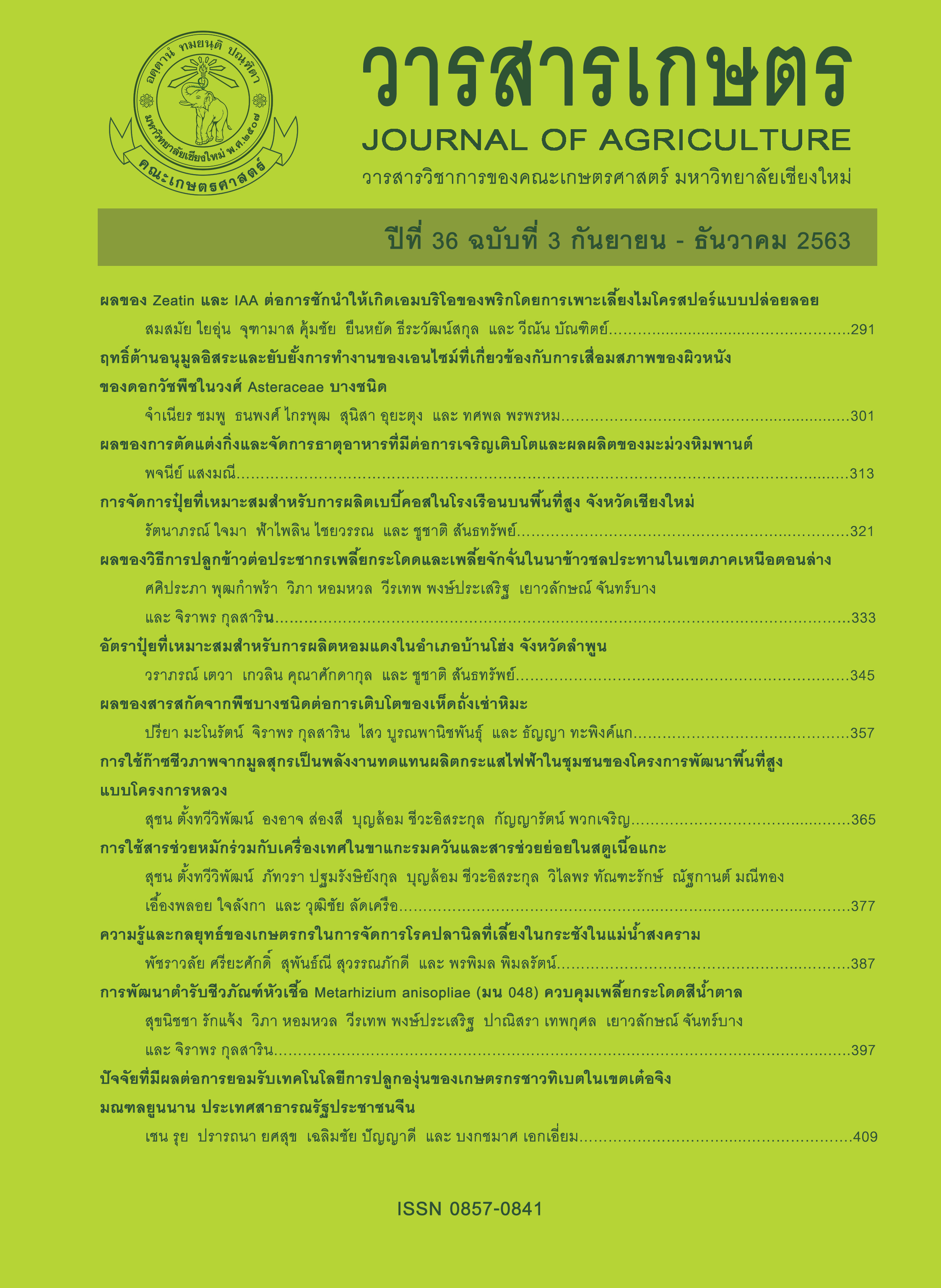การใช้ก๊าซชีวภาพจากมูลสุกรเป็นพลังงานทดแทนผลิตกระแสไฟฟ้าในชุมชน ของโครงการพัฒนาพื้นที่สูงแบบโครงการหลวง
Main Article Content
บทคัดย่อ
การศึกษานี้มีวัตถุประสงค์เพื่อนำก๊าซชีวภาพมาประยุกต์ใช้เป็นพลังงานทดแทนน้ำมันก๊าซโซลีน (น้ำมันเบนซิน) กับเครื่องยนต์ขนาด 7.5 แรงม้าที่มีเครื่องกำเนิดไฟฟ้าขนาด 3 กิโลวัตต์ ผลิตกระแสไฟฟ้าสำหรับใช้ในชุมชนของโครงการพัฒนาพื้นที่สูงแบบโครงการหลวงแม่สอง อำเภอท่าสองยาง จังหวัดตาก จำนวน 3 ราย และแบบโครงการหลวงแม่สามแลบ อำเภอสบเมย จังหวัดแม่ฮ่องสอน จำนวน 1 ราย โดยใช้บ่อผลิตก๊าซชีวภาพของเกษตรกรทั้ง 4 ราย ซึ่งมีขนาด 8, 12, 8+8 และ 16 ลูกบาศก์เมตร พบว่า มีปริมาณก๊าซไฮโดรเจนซัลไฟด์หรือไข่เน่า (H2S) ปนในก๊าซชีวภาพเท่ากับ 755.00, 894.00, 836.67 และ 1,493.33 ppm ตามลำดับ โดยชุดกรองที่จัดทำขึ้นจากสารเคลือบด้วยเฟอริกไฮดรอกไซด์ Fe(OH)3 สามารถกำจัดก๊าซไข่เน่าได้ 99.73-99.91% และสามารถใช้ผลิตกระแสไฟฟ้าตามความต้องการใช้งานของเกษตรกรทั้ง 4 ราย ได้นาน 1.84, 2.23, 3.14 และ 4.01 ชั่วโมงต่อวัน ช่วยลดค่าใช้จ่ายได้ 76.63, 96.31, 111.34 และ 130.83 บาทต่อเดือน ตามลำดับ ซึ่งค่าดังกล่าวแตกต่างกันอย่างมีนัยสำคัญตามขนาดของบ่อก๊าซชีวภาพ (P<0.01) สรุปได้ว่า การผลิตก๊าซชีวภาพสามารถผลิตได้แม้จะอยู่ในที่สูงกว่า 1,000 เมตร และสามารถใช้ผลิตกระแสไฟฟ้าบนพื้นที่สูงได้ โดยเกษตรกรผู้ใช้งานมีความพึงพอใจในระดับ “มากที่สุด” มีคะแนนเฉลี่ยเท่ากับ 4.99 จากคะแนนเต็ม 5
Article Details
เอกสารอ้างอิง
Amaral, A.C., A. Kunz, R.L.R. Steinmetz, L.A. Scussiato and D.C. Tapparo. 2015. Anaerobic digestion of swine manure: stratified production units and its biogas potential. (Online). Available: https://www. researchgate.net/publication/278019082_anaerobic_digestion_of_swine_manure_stratified_production_units_and_its_biogas_potential(September 1, 2019)
Ayade, M. and A.A. Latey. 2016. Performance and emission characteristics of biogas-petrol dual fuel in SI engine. International Journal of Mechanical Engineering and Technology 7(2): 45-54.
Department of Alternative Energy Development and Efficiency. 2013. Thailand Energy Efficiency Situation 2013. Department of Alternative Energy Development and Efficiency, Bangkok. 42 p. (in Thai)
Driehaus, W., M. Jekel and U. Hildebrandt. 1998. Granular ferric hydroxide-a new absorbent for the removal of arsenic from natural water. Journal of Water Supply: Research and Technology-Aqua 47(1): 30-35.
Irvan, B. Trisakti, T. Husaini, A. Sitio and T.B. Sitorus. 2017. Performance evaluation on Otto engine generator using gasoline and biogas from palm oil mill effluent. IOP Conference Series: Materials Science Engineering 206 012028, doi: 10.1088/1757-899X/206/1/012028.
Kristoferson, L.A. and V. Bokalders. 1991. Renewable Energy Technologies: Their Applications in Developing Countries. ITDG Publishing, London.
Landahl, G. 2003. Biogas as Vehicle Fuel: A European Overview. Trendsetter Report No. 2003:3. Stockholm Environment Administration, Stockholm. 51 p.
Mihic, S. 2004. Biogas fuel for internal combustion engines. Annals of the Faculty of Engineering Hunedoara. Tome II, Fascicole 3: 179-190.
Patzer, B. 1997. Colloidal suspensions and physical science: Possible classroom applications to Hanford and wastewater treatment. (Online). Available: https:// legacy.voiland.wsu.edu/modules/97modules/patzer/module.htm (September 1, 2019)
Persson, M. 2007. Biogas upgrading and utilization as vehicle fuel. pp 59-64. In: Proceedings of European Biogas Workshop: The Future of Biogas in Europe III, University of Southern Denmark, Esbjerg, Denmark.
Songsee, O. 2012. Production of biogas as a renewable energy source for small farm engines. Final Report. Ministry of Science and Technology, Bangkok. 77 p. (in Thai)
Steel, R.G.D. and J.H. Torrie. 1980. Principles and Procedures of Statistics: A Biometrical Approach. 2nd ed. McGraw-Hill Book Co. Inc., New York.
Supasathitkul, W.1986. Diatomite insulating brick. B.Sc. Special Problem, Department of Industrial Chemistry, Faculty of Science, Chiang Mai University, Chiang Mai. (in Thai)
Tangtaweewipat, S., O. Songsee, B. Cheva-Isarakul, T. Songkun and A. Seepai. 2009. Biogas production for decreasing environmental problems and being as a renewable energy source in small farm holders. Final Report. Ministry of Science and Technology, Bangkok. 221 p. (in Thai)
Tangtaweewipat, S., O. Songsee, B. Cheva-Isarakul, P. Polperm and S. Chaimanee. 2011a. Research and development on efficiency of biogas production for small farm holders in highland area. Final Report. Highland Research and Development Institute (Public Organization), Chiang Mai. 88 p. (in Thai)
Tangtaweewipat, S., O. Songsee, B. Cheva-Isarakul and A. Seepai. 2011b. Diminishing of hydrogen sulfide and carbon dioxide from biogas for community use. Final Report. National Science and Technology Development Agency (Northern Branch), Ministry of Science and Technology, Bangkok. 56 p. (in Thai)
Tangtaweewipat, S., B. Cheva-Isarakul, O. Songsee, W. Thantharak and K. Puakchareon. 2018. Biogas Production for Decreasing Environmental Problems and Using as an Energy Source in Kitchen. 8th ed. Trio Advertising & Media Co. Ltd., Chiang Mai. 36 p. (in Thai)
Tangtaweewipat, S., O. Songsee, B. Cheva-Isarakul, K. Puakchareon, W. Thantharak and K. Umetsu. 2019. Use of biogas as a renewable energy source for producing electricity on highland area. Khon Kaen Agriculture Journal 47(Suppl. 2): 397-404. (in Thai)
Thirunavukkarasu, O.S., T. Viraraghavan and K.S. Subramanian. 2003. Arsenic removal from drinking water using granular ferric hydroxide. Water SA 29(2): 161-170.


